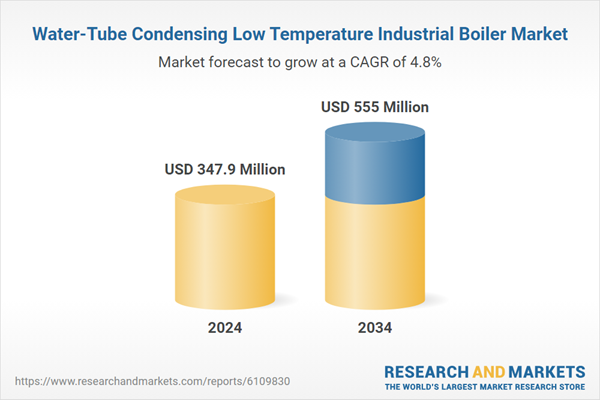As environmental regulations tighten and industrial operations emphasize sustainability, the demand for boilers that combine energy performance with reduced emissions is expected to rise. These systems enhance fuel efficiency and align with global energy efficiency targets. Evolving industrial needs, particularly for precise thermal control in manufacturing environments like primary metals and food production, are shaping a favorable growth trajectory. The integration of predictive analytics, modular designs, and smart controls is expected to transform reliability, fuel use, and operational stability across industries based on accurate and consistent heat delivery.
The natural gas segment in the water-tube condensing low temperature industrial boiler market is projected to reach USD 180 million by 2034. These systems are for high-demand industrial settings where maintaining temperature precision directly influences product quality and operational throughput. Industries that depend on consistent thermal control are finding these natural gas boilers especially suited to their needs, thanks to both their energy efficiency and reliability under variable load conditions.
The water-tube condensing low temperature industrial boiler market in the pulp & paper segment is forecasted to grow at a CAGR of 4.9% through 2034. These units are equipped with advanced safety technologies, intelligent monitoring capabilities, and automated shutdown features, all of which ensure compliance with safety standards while improving performance consistency and risk mitigation. This focus on performance and safety is encouraging adoption across industrial applications that rely on uninterrupted thermal processes.
United States Water-Tube Condensing Low-Temperature Industrial Boiler Market was valued at USD 43.9 million in 2024. With growing emphasis on reducing emissions and improving energy efficiency, businesses across the country are increasingly turning to these advanced boiler systems. The shift toward greener technologies and thermal management supports market growth in the US.
The competitive landscape includes major companies such as Cleaver-Brooks, Babcock Wanson, EPCB Boiler, Miura America, Fulton, Victory Energy Operations, Clayton Industries, Rentech Boilers, Johnston Boiler, IHI Corporation, Burnham Commercial Boilers, Hurst Boiler & Welding, Thermodyne Boilers, Thermax, and Babcock & Wilcox.
To strengthen their market foothold, key players in the water-tube condensing low-temperature industrial boiler sector are focusing on innovation, sustainability, and global expansion. Companies are heavily investing in R&D to develop next-gen boilers with better heat recovery, lower emissions, and enhanced fuel flexibility. Many companies adopt smart control technologies, allowing real-time monitoring and predictive maintenance, minimizing downtime and operational costs. Strategic partnerships and acquisitions are also being used to expand product portfolios and enhance service networks.
Comprehensive Market Analysis and Forecast
- Industry trends, key growth drivers, challenges, future opportunities, and regulatory landscape
- Competitive landscape with Porter’s Five Forces and PESTEL analysis
- Market size, segmentation, and regional forecasts
- In-depth company profiles, business strategies, financial insights, and SWOT analysis
This product will be delivered within 2-4 business days.
Table of Contents
Companies Mentioned
- Babcock & Wilcox
- Babcock Wanson
- Burnham Commercial Boilers
- Clayton Industries
- Cleaver-Brooks
- EPCB Boiler
- Fulton
- Hurst Boiler & Welding
- IHI Corporation
- Johnston Boiler
- Miura America
- Rentech Boilers
- Thermax
- Thermodyne Boilers
- Victory Energy Operations
Table Information
| Report Attribute | Details |
|---|---|
| No. of Pages | 125 |
| Published | June 2025 |
| Forecast Period | 2024 - 2034 |
| Estimated Market Value ( USD | $ 347.9 Million |
| Forecasted Market Value ( USD | $ 555 Million |
| Compound Annual Growth Rate | 4.8% |
| Regions Covered | Global |
| No. of Companies Mentioned | 15 |









